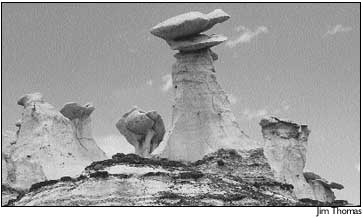|
July 12, 2001
BY JIM THOMAS The Bisti Wilderness is 3,946 acres of seemingly barren and lifeless badlands. However, for those hearty souls who like to hike in the desert and see scenery unlike almost anything around, this is the place. Hikers can hop back some 70 million years when the region was lush, leafy and home to many large reptiles (dinosaurs) and mammals. Their fossilized remains are embedded in the rocks at Bisti and have been an important record of the region's transition from coastal swamp to inland floodplain. The Badlands are administered by the BLM (Bureau of Land Management), and are known officially, but less evocatively as the Bisti Wilderness Area. There is a small signposts pointing the way to the Badlands from Farmington and that is the best approach route is along NM 371 from Farmington. Located 40 miles south of town, the Bisti Wilderness is a barren of weirdly eroded hoodoos and slate-topped "mesitas" geological formations made up of sandstone and shale that have become eroded from eons of time of wind and rain. Once considered by the Navajo as the dwelling place of "sacred ones," the colorful sandstone formations crowning the peak were shaped over millions of years. The wilderness area is distinguished by several unique geological formations that give the landscape its eerie cast. Hoodoos are rock columns sculpted into odd, fantastical shapes. There also are huge spires of red sandstone. Motorized travel and mountain bikes are prohibited in the wilderness, but there is lots of room for hiking and backpacking. Recently, I conned my wife, Tricia, and fellow Cortez Journal workmates Wendy and Jim Mimiaga, and Katharhynn Heidelberg for a day-long hike one early spring day. The weather was cool but not cold. Walking was easy. We brought plenty of water because there is no water anywhere, so pack in a large supply. We took along a picnic lunch. Hikers should also pack some food. The horizon seems to look the same, therefore, getting turned around is easy. This is a little visited and largely unknown area. There is a place to park but not for many cars. In fact, the day we went we saw only a couple and a few other hikers. After a few minutesí walk into the wilderness, and passing through the fenced in areas, the parking lot and the road were soon out of sight and the surreal landscape surrounded us. We traveled northwest. The clayish hills are composed of layers of coal, silt, shale and mudstone with varying hardness and coloration, and are mixed with more resistant sandstone which has eroded into weird formations. Many small ravines created by rainwater erosion cross through the hills, and there are also occasional mini caves and fissures several meters deep. Much of the surface is unstable - the layers are often loose, rocks are crumbling and some of the formations are quite delicate. Hikers should take care not to damage the features; there are no established trails, but walking along the ravines is the usual way to explore. Petrified wood is scattered across the surface - sometimes entire tree stumps, with the bark still clearly recognizable. Dino fossils are easily seen in the rock strata. Those lucky enough can see teeth and bones of a variety of species including dinosaurs are embedded in the layers. We did not see any fossilized bones but we did see several petrified trees. There were times we could look all around and not see even plant life. In some places, it looked as though you were standing on the moon. Wendy Mimiaga said the Bisti Badlands is an amazingly scenic and colorful place to photograph. She took roll after roll of both color and black-and-white film of the weird formations. Some of the large expanse of undulating mounds and unusual eroded rocks made for some very interesting shots. The best time of year to go is probably in the early fall when there is no wind. The early spring is not too bad, either, but there is not much protection from the wind. The winter months are too cold as the area is above 6,000 feet. The summer time is too hot. |
||
|
Copyright © 2001 the Cortez Journal.
All rights reserved. |
